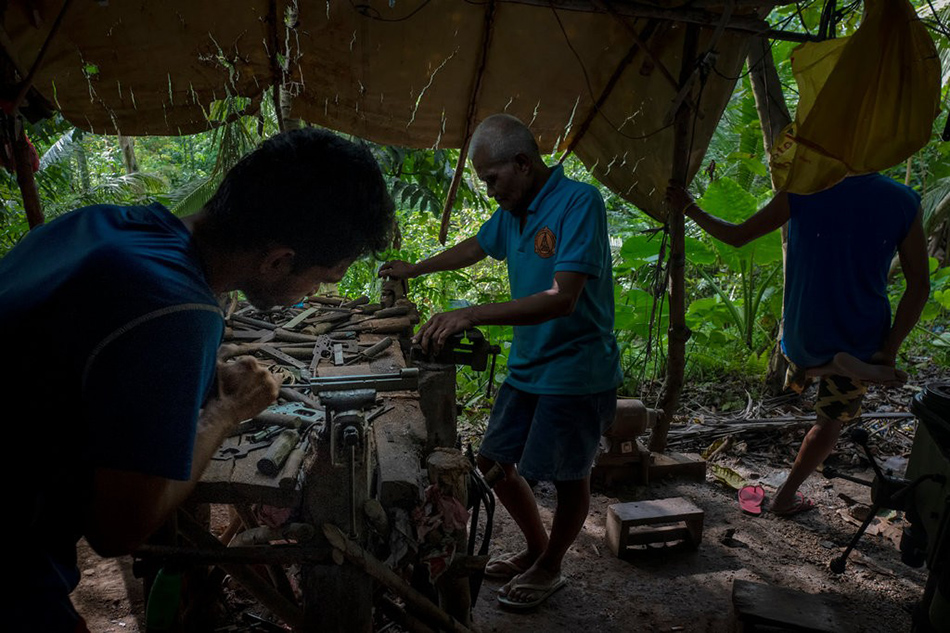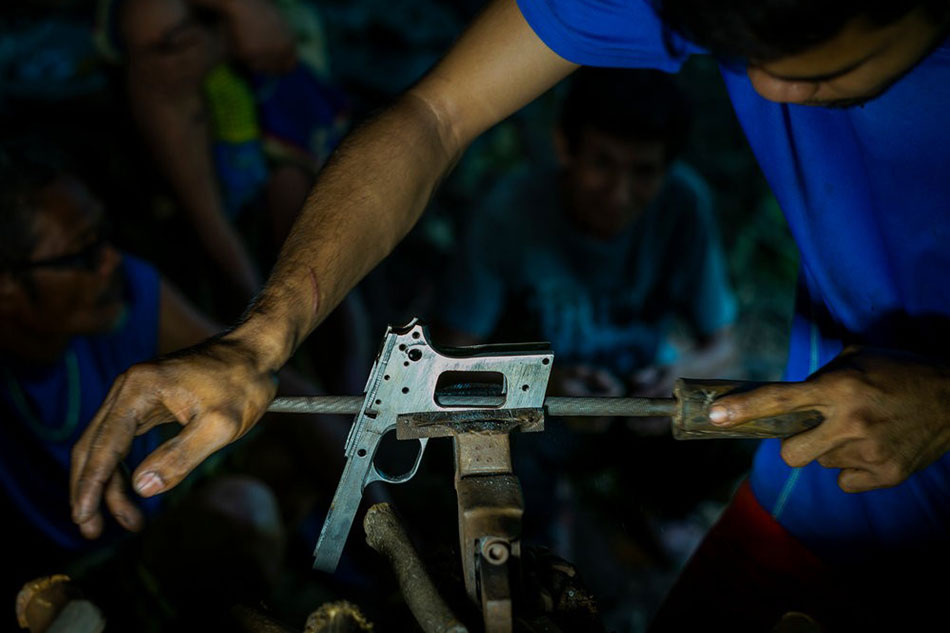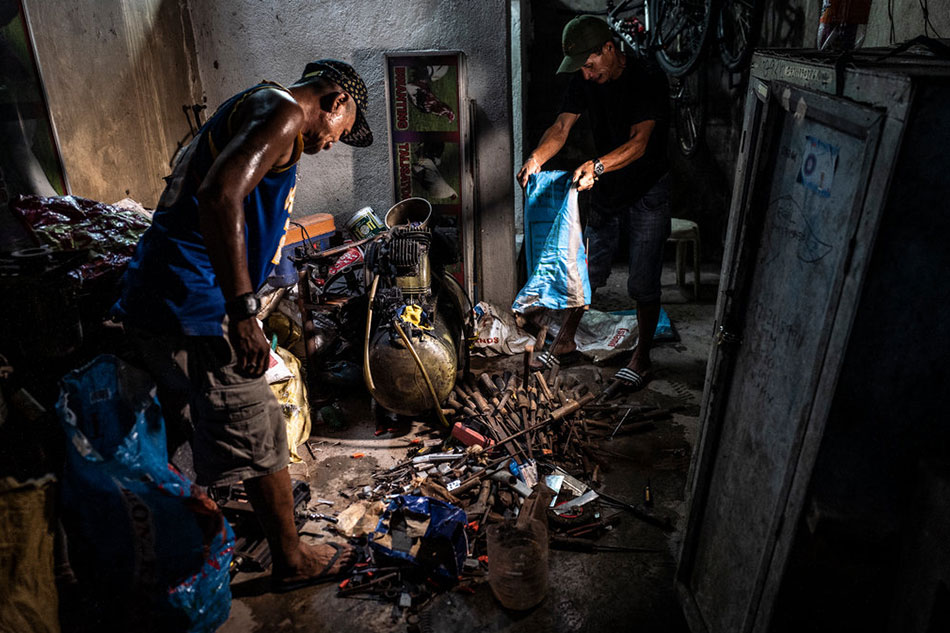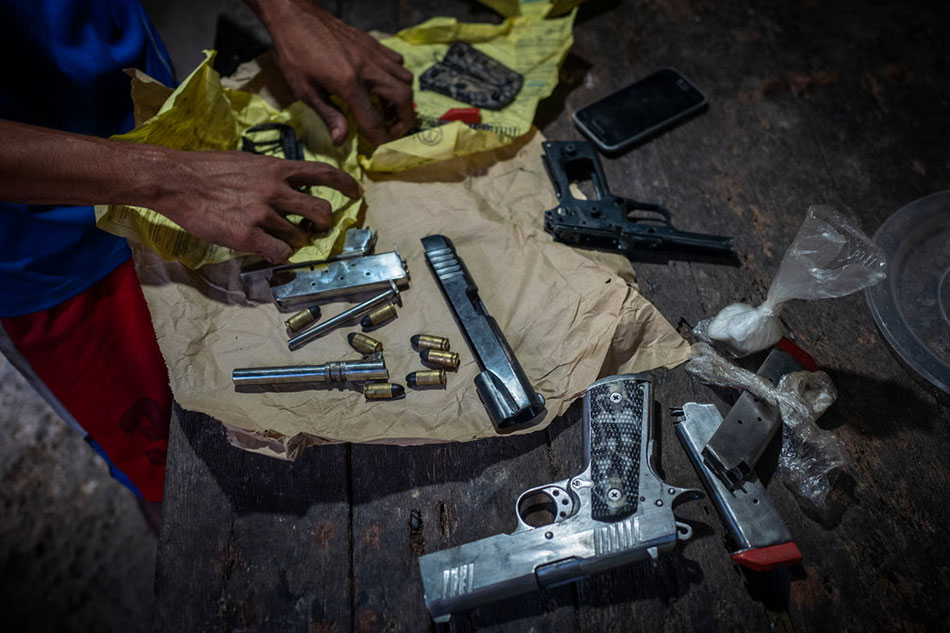A Family Craft With a Deadly Toll: Illegal Gun Making | ABS-CBN

Welcome, Kapamilya! We use cookies to improve your browsing experience. Continuing to use this site means you agree to our use of cookies. Tell me more!
A Family Craft With a Deadly Toll: Illegal Gun Making
A Family Craft With a Deadly Toll: Illegal Gun Making
Jason Gutierrez,
The New York Times
Published Apr 08, 2019 09:33 PM PHT
|
Updated Apr 09, 2019 01:00 AM PHT
DANAO, Philippines — In the remote, mist-covered slopes outside the city of Danao in the central Philippines sits the illegal, makeshift workshop of a master gun maker.
DANAO, Philippines — In the remote, mist-covered slopes outside the city of Danao in the central Philippines sits the illegal, makeshift workshop of a master gun maker.
Accessible only by foot on a steep, winding pathway camouflaged by thick vegetation, the ramshackle shop owned by I. Launa has a tattered tarpaulin roof, a work table and several machines for cutting and shaping steel. The whole operation can be packed up and moved on short notice.
Accessible only by foot on a steep, winding pathway camouflaged by thick vegetation, the ramshackle shop owned by I. Launa has a tattered tarpaulin roof, a work table and several machines for cutting and shaping steel. The whole operation can be packed up and moved on short notice.
Illegal gun making is a livelihood that has helped put food on the table and send the family’s children to school since the 1970s, and Mr. Launa, who asked that only the initial of his first name be used for fear of being arrested, is just one of a host of such small-scale gunsmiths in the region. His village alone is home to about a dozen.
Illegal gun making is a livelihood that has helped put food on the table and send the family’s children to school since the 1970s, and Mr. Launa, who asked that only the initial of his first name be used for fear of being arrested, is just one of a host of such small-scale gunsmiths in the region. His village alone is home to about a dozen.
The trade — which contributes to the estimated two million unregistered guns in the Philippines, slightly more than the 1.7 million legally registered weapons — is able to flourish in a remote place where jobs are scarce, police presence is thin and lawlessness runs deep.
The trade — which contributes to the estimated two million unregistered guns in the Philippines, slightly more than the 1.7 million legally registered weapons — is able to flourish in a remote place where jobs are scarce, police presence is thin and lawlessness runs deep.
ADVERTISEMENT
Gun making “is an essential craft passed on from one generation to another here,” said Mr. Launa, 63, who learned the craft from his father and has now taught it to his son.
Gun making “is an essential craft passed on from one generation to another here,” said Mr. Launa, 63, who learned the craft from his father and has now taught it to his son.
“Many presidents have come and gone,” he added, as a single fluorescent light illuminated the table in front of him, where several unfinished Colt .45 pistol replicas lay. “But we are still here.”
“Many presidents have come and gone,” he added, as a single fluorescent light illuminated the table in front of him, where several unfinished Colt .45 pistol replicas lay. “But we are still here.”
Gunsmithing blossomed in the area during World War II, as locals were taught to make weapons to support a guerrilla movement fighting the Japanese. By the 1960s, Danao had become the go-to place for outlaws and ordinary citizens wanting cheap but high-quality replicas.
Gunsmithing blossomed in the area during World War II, as locals were taught to make weapons to support a guerrilla movement fighting the Japanese. By the 1960s, Danao had become the go-to place for outlaws and ordinary citizens wanting cheap but high-quality replicas.
Once these gun makers would sell their products out in the open, but now they employ runners to surreptitiously deliver their wares. Sometimes, a broker stops by to commission a gun for a client.
Once these gun makers would sell their products out in the open, but now they employ runners to surreptitiously deliver their wares. Sometimes, a broker stops by to commission a gun for a client.
In the 1990s, an effort was made to legalize the trade by regulating gun makers, but the project failed to win government support.
In the 1990s, an effort was made to legalize the trade by regulating gun makers, but the project failed to win government support.
The handguns — which even an enthusiast would have a hard time determining are illegal copies, down to the “Colt Automatic Caliber .45 Government Model” engraving — are sold to buyers for around 7,000 pesos, about $130, much cheaper than authentic models.
The handguns — which even an enthusiast would have a hard time determining are illegal copies, down to the “Colt Automatic Caliber .45 Government Model” engraving — are sold to buyers for around 7,000 pesos, about $130, much cheaper than authentic models.
Other weapons, like submachine guns, can be commissioned, too, although orders for the higher caliber weapons have become slow amid a government crackdown.
Other weapons, like submachine guns, can be commissioned, too, although orders for the higher caliber weapons have become slow amid a government crackdown.
The craft practiced here is taking a deadly toll across the country.
The craft practiced here is taking a deadly toll across the country.
The police say that hit men working for rival politicians have been known to source their weapons from the Danao area, and that sales have picked up slightly as the country prepares for elections in May. Several politicians have been killed in election-related violence.
The police say that hit men working for rival politicians have been known to source their weapons from the Danao area, and that sales have picked up slightly as the country prepares for elections in May. Several politicians have been killed in election-related violence.
Danao-made guns, according to the police, have been found at the site of extrajudicial killings, which have been attributed to pro-government militias carrying out orders by President Rodrigo Duterte to stamp out drug crimes.
Danao-made guns, according to the police, have been found at the site of extrajudicial killings, which have been attributed to pro-government militias carrying out orders by President Rodrigo Duterte to stamp out drug crimes.
The police have said the guns have also made their way into the hands of Abu Sayyaf, a small but violent terrorist group in the south that is increasingly allying itself with the Islamic State.
The police have said the guns have also made their way into the hands of Abu Sayyaf, a small but violent terrorist group in the south that is increasingly allying itself with the Islamic State.
“Right now, anyone can buy a gun here, as long as you have the money to pay, even if you were a thief, a killer or a gun for hire,” said the local police chief, Col. Jaime Quiocho, who noted the appeal of such illicit purchases to criminals. “Will you buy a gun that is licensed and can be traced back to you?”
“Right now, anyone can buy a gun here, as long as you have the money to pay, even if you were a thief, a killer or a gun for hire,” said the local police chief, Col. Jaime Quiocho, who noted the appeal of such illicit purchases to criminals. “Will you buy a gun that is licensed and can be traced back to you?”
Bordered by rugged mountain ranges, Danao lies 20 miles from Cebu, the bustling main city of the central Philippines. An electronics factory provides jobs to a portion of the population of 130,000, which is mostly Catholic and mostly poor, though farming and fishing are the main industries.
Bordered by rugged mountain ranges, Danao lies 20 miles from Cebu, the bustling main city of the central Philippines. An electronics factory provides jobs to a portion of the population of 130,000, which is mostly Catholic and mostly poor, though farming and fishing are the main industries.
At Mr. Launa’s workshop, which on any given day might be working on four gun orders, metal cuts of gun parts were scattered on the table.
At Mr. Launa’s workshop, which on any given day might be working on four gun orders, metal cuts of gun parts were scattered on the table.
His 28-year-old son was fine-tuning a barrel and a trigger mechanism for a pistol. He chiseled and hammered every inch of the weapon before assembling it and repeatedly checking its mechanism. As a final test, he fired into a hole in the ground.
His 28-year-old son was fine-tuning a barrel and a trigger mechanism for a pistol. He chiseled and hammered every inch of the weapon before assembling it and repeatedly checking its mechanism. As a final test, he fired into a hole in the ground.
Asked whether he ever felt guilty knowing his guns might have been used in summary killings, Mr. Launa said, “I make guns, but I don’t tell people to kill others.”
Asked whether he ever felt guilty knowing his guns might have been used in summary killings, Mr. Launa said, “I make guns, but I don’t tell people to kill others.”
The popularity of its guns has, in a way, made the local industry a victim of its own success. The more the guns have become known, the more they have attracted the eyes of organized groups of thieves and of police officers who want to shut the workshops down.
The popularity of its guns has, in a way, made the local industry a victim of its own success. The more the guns have become known, the more they have attracted the eyes of organized groups of thieves and of police officers who want to shut the workshops down.
An estimated two million unregistered guns are owned in the Philippines, greater than the number of registered weapons.
An estimated two million unregistered guns are owned in the Philippines, greater than the number of registered weapons.
“We have to hide, because one has to be careful nowadays,” Mr. Launa said.
“We have to hide, because one has to be careful nowadays,” Mr. Launa said.
Colonel Quiocho acknowledged that the gun makers had little incentive or opportunity to abandon a trade that has provided a livelihood for generations.
Colonel Quiocho acknowledged that the gun makers had little incentive or opportunity to abandon a trade that has provided a livelihood for generations.
“It has been a way of life for many,” he said. “If they stop it, what will happen to them?”
“It has been a way of life for many,” he said. “If they stop it, what will happen to them?”
The police chief said pursuing illegal gun makers was only a stopgap measure that could not fully solve a problem also rooted in poverty. That isn’t to say he has given up trying.
The police chief said pursuing illegal gun makers was only a stopgap measure that could not fully solve a problem also rooted in poverty. That isn’t to say he has given up trying.
The police conducted about 70 raids last year that led to the seizure of about 92 firearms, Colonel Quiocho said. Charges were filed against around 80 people, though some were released on bail.
The police conducted about 70 raids last year that led to the seizure of about 92 firearms, Colonel Quiocho said. Charges were filed against around 80 people, though some were released on bail.
Tracking down the gun makers has not been easy. Many of them have spies who inform them of impending raids, giving them time to move to another location. Others have migrated elsewhere.
Tracking down the gun makers has not been easy. Many of them have spies who inform them of impending raids, giving them time to move to another location. Others have migrated elsewhere.
The police chief suggested legalizing the industry so that Danao guns could be properly tracked.
The police chief suggested legalizing the industry so that Danao guns could be properly tracked.
“They will make guns whether we like it or not,” he said. “So why not control the industry, their quality and where they go?”
“They will make guns whether we like it or not,” he said. “So why not control the industry, their quality and where they go?”
Impressed by the quality of the confiscated guns he came across in the course of raids, Colonel Quiocho said Danao gun makers could compete with other manufacturers in the region if given the support.
Impressed by the quality of the confiscated guns he came across in the course of raids, Colonel Quiocho said Danao gun makers could compete with other manufacturers in the region if given the support.
“Gunsmiths here can make replicas just by looking at the pictures,” he said. “That is a testament to their advanced skills. They can compete with high-end makers.”
“Gunsmiths here can make replicas just by looking at the pictures,” he said. “That is a testament to their advanced skills. They can compete with high-end makers.”
Francisco Lara Jr. of International Alert Philippines, a conflict monitoring group, said he agreed that Danao guns should be legalized, to “stem the product and flow of illicit weapons into the market.”
Francisco Lara Jr. of International Alert Philippines, a conflict monitoring group, said he agreed that Danao guns should be legalized, to “stem the product and flow of illicit weapons into the market.”
The city government has tried to offer alternative livelihoods, though it has been a tough sell in a place where gun making is ingrained in the fabric of society.
The city government has tried to offer alternative livelihoods, though it has been a tough sell in a place where gun making is ingrained in the fabric of society.
Mr. Launa’s son initially set out on a different path.
Mr. Launa’s son initially set out on a different path.
After finishing high school, he hoped to support himself with a job in the city so that he could save up to study to become an engineer. But his menial jobs paid just enough to eat, and eventually he decided to return home.
After finishing high school, he hoped to support himself with a job in the city so that he could save up to study to become an engineer. But his menial jobs paid just enough to eat, and eventually he decided to return home.
“So here I am,” he said. “I make guns for a living. It is an honest job.”
“So here I am,” he said. “I make guns for a living. It is an honest job.”
ADVERTISEMENT
ADVERTISEMENT






